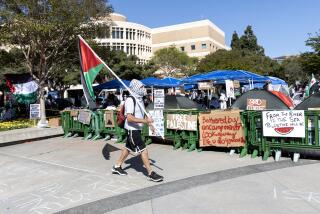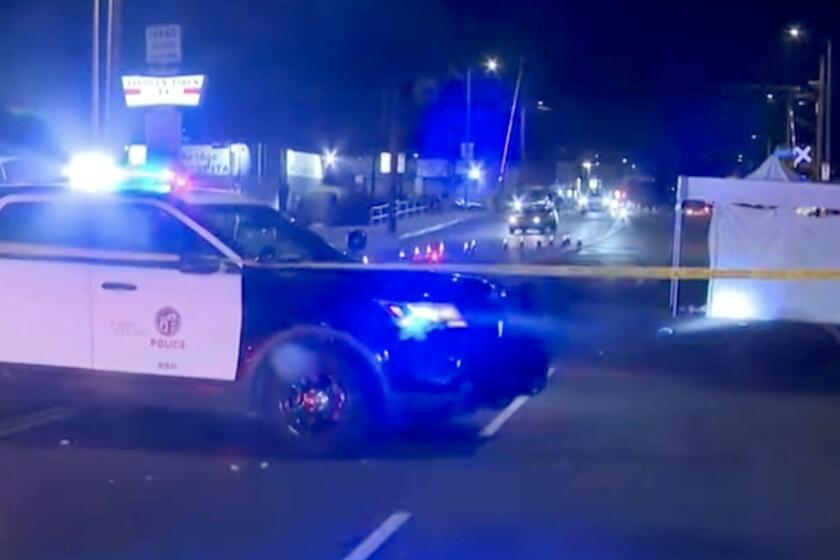Settling school disputes before they escalate
Monica Gonzalez had to persuade her mother to allow her to attend Charles Maclay Middle School, the local junior high just blocks from her Pacoima home.
Older cousins enrolled there told tales of daily fistfights, and she said her mother worried about the 11-year-old sixth-grader walking through the troubled neighborhood. After a lot of pleading, her mother relented.
As a way to help make the school safer, Monica recently spent several days training with 25 other students to become peer mediators. The program, funded by the Center for Civic Mediation, a Los Angeles-based nonprofit, teaches students how to resolve conflict and learn to coexist peacefully among their classmates.
“I keep thinking about what my mom said, that this school is not good,” Monica said. “I told my mom that now I’m in peer mediation, I can make the school better.”
Such programs have been around for decades, but at Maclay, peer mediation has only recently become one of many strategies to reduce the number of violent incidents. Since the program began in 2010, it has steadily helped lower the number of instructional days lost to suspensions but has yet to make strides when it comes to physical altercations.
Last school year, student fights led to 67 days of suspensions, an increase from the previous year’s 50.
However, the number of instructional days lost to suspensions for a range of offenses has steadily declined over the years. In 2007-08, Maclay had 418 days of suspensions; last year it had 152.
Peer mediators would never handle such serious violations as drug or weapon possession. Those cases would go straight to the principal. Instead, the students help squelch simmering disputes before they escalate to fistfights or worse. In the last 1 1/2 years, almost 100 cases were referred to the peer mediators.
Lauro Cons III, the school’s full-time peer mediation coordinator, attends the sessions with feuding students. Mediators don’t give advice or take sides. They attempt to open the lines of communication by helping their classmates find the root of their conflict. The students come to their own resolution.
Cons has found that students are more open with others their own age. For middle-schoolers, an adult presence typically symbolizes an authority figure — someone they might not open up to.
“It makes disputants feel more comfortable, that adults are not taking the reins, but that their peers are navigating the conversation,” he said.
In December, Cons’ team of peer mediators was brought in when a black student and a Latino student started throwing books and racial slurs at each other in the middle of class. The youngsters worked through their problems and avoided a lengthy suspension.
But Cons’ position may be in jeopardy. The Center for Civic Mediation, which pays his salary, is scrambling to raise funds after an investor pulled out.
“We’re committed to keeping it going by hook or by crook, but we will find a way,” said Tobi Inlender, the executive director.
Principal Veronica Arreguin said there is a noticeable difference at the school.
“There are things that cannot be measured in numbers,” Arreguin said. “That’s the smiles on the faces as students walk in the door.”
Just like the student body, Maclay itself is undergoing a transformation. Because of consistently low test scores, the school has been placed in a public school choice program in which low-performing campuses can be taken over by applicants inside or outside the district. In the last school year, Maclay scored 660 on the Academic Performance Index; the state target is 800. Arreguin hopes to win control of the school; she has drawn up a five-year plan that asks for autonomy over it.
Maintaining the mediators is part of the plan to reach students with behavioral issues.
“Peer mediation models for them the appropriate way to speak when you have a conflict,” the principal said. “That’s why it works.”
Most of the aspiring peer mediators are just six months removed from the protective shield of elementary school, but they aren’t strangers to violence and conflict. Maclay sits at Glenoaks Boulevard and Pierce Street, at the intersection of a gang injunction zone and public housing. Sometimes what’s happening on the streets spills inside the school’s gates.
Some students, like Itzel Jimenez, 12, became interested in the position after an argument with a friend almost turned physical, and she was sent to Cons’ office.
“It helped it me through a lot of problems I had,” the seventh-grader said. “I figured if people could help me, then I can help others.”
More to Read
Sign up for Essential California
The most important California stories and recommendations in your inbox every morning.
You may occasionally receive promotional content from the Los Angeles Times.











